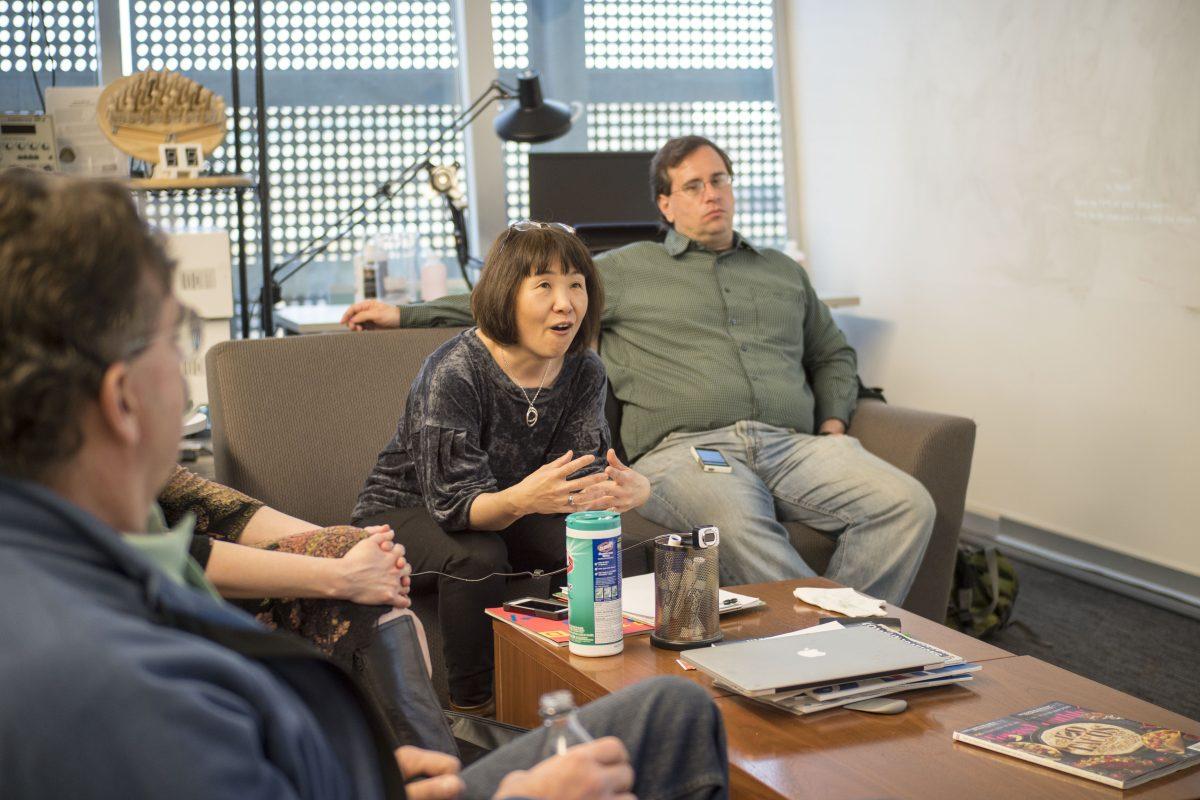One UTD professor joined with students and faculty members to develop a new teaching tool after experiencing learning difficulties in her high school physics class. The team has since received a seven figure research grant to develop a computer-based program that simplifies the learning process.
Associate professor of arts, technology and emerging communications Midori Kitagawa is the principal investigator for the Scaffolded Training Environment for Physics Programming, a project with the goal of simplifying physics education for high school students nationwide, while also teaching them computational thinking skills.
Kitagawa received a $1 million grant from the National Science Foundation to fund her research into STEPP, which allows students to go through modules where they build models simulating various scenarios in physics problems, and then use those models to understand physics concepts. She plans to conduct testing with two Richardson ISD computer science and physics teachers, as well as 160 students, to gather feedback on the program for further development.
The professor initially came up with the idea about four years ago while driving and listening to NPR. Kitagawa said she realized that synergistic learning could help students understand concepts more easily.
“If kids are learning French and … learn some other subject like math in French, their understanding of math and acquiring of French are much better than learning the two separately,” Kitagawa said. “I thought, well, computer programming is a language, so teaching physics using programming language might help students learn physics and programming better than learning them separately.”
Computer science graduate Monisha Elumalai is a research assistant on STEPP, and explained that while she received her high school education outside of the United States, she can understand why this program may be helpful to students.
“I think understanding physics from an interactive perspective, or any subject for that matter, is always more helpful, and I think this would help students not just understand what’s going on, but also get a better idea of what they can do further with it,” Elumalai said. “I know the words, but I don’t know where they’re getting applied in real life every day, so if you can bring that to them, I think they can see physics from a different point of view.”
Kitagawa began recruiting other UTD professors, including computer science professor and ATEC Distinguished Chair Paul Fishwick, in fall 2014. The team submitted their proposal to the National Science Foundation and received approval in August 2017. A team of research assistants, including computer science doctoral students Kira Jin and Zheheng Zhao, along with physics senior Baily Hale, physics doctoral student Nathan Steinle and Elumalai developed the Finite State Machine, allowing students with no coding experience to build their own simulations. Fishwick explained that the FSM is a way of simplifying the translation between physics and English.
“It’s a way of formalizing English to be on top of the physics … so you have something that you understand in natural language: initial state, increase velocity, it’s the kind of stuff we might talk about once we learn the elements of physics,” Fishwick said. “So the FSM is a kind of visual language for formally representing English concepts and language which we already know.”
Other co-investigators on the project include physics assistant professor Michael Kesden, planetary scientist and associate professor of science and math education Mary Urquhart and Rosanna Guadagno, a social psychologist and researcher at Stanford University’s Peace Innovation Lab.
STEPP runs on Unity, a video game engine allowing students to run the simulations on various platforms including smartphones, PlayStations and computers. While this platform gives the program accessibility, Kesden said it also became an obstacle during development. In video games, the interface conveys important information to the player using visual components such as text and avatars, as well as characters, sounds and buttons. The available interfaces running on Unity didn’t expand on the physics behind certain movements, and the team couldn’t personalize the program’s design.
“Most of these interfaces were designed for game design, so they’re trying to suppress the physics and have the physics built in for you, so you don’t have to face it yourself,” Kesden said. “For us, we’re trying to teach the physics and make it much more explicit, and so that kind of mismatch between the primary intended users for these plug-ins versus the goals of our program, we decided to just make our own interface and not rely on those built-in packages.”
The team’s custom interface allows students to go through levels that present more difficult scenarios as the students learn about more advanced concepts.
Richardson ISD physics teacher Clay Stanfield provides feedback to Kitagawa’s team so they know how to format STEPP’s content for on-level physics students.
“(The team) has our curriculum, so we’re trying to get the modules to fit into that as seamlessly as possible,” Stanfield said. “They have to know where we’re starting from and what our long-term goal is in terms of our curriculum.”
Testing is set to begin in June with the Women in Physics camp attendees who will be trying out the team’s first module for usability. Urquhart said the team gauges student understanding through a well-researched diagnostic physics content knowledge test.
Guadagno added that one of the program’s long-term goals is to increase diversity in STEM fields by making the physics concepts easier to understand, as well as making the program more accessible through multiple platforms. She also said the program’s main long-term goal is to increase the number of students who choose to go into STEM careers.
“Hopefully the experimental aspect of this will demonstrate that by learning physics and computer programming together, what it will do in the long run is be an enjoyable experience that builds people’s confidence and belief in themselves and their ability to engage with STEM fields,” Guadagno said.

















